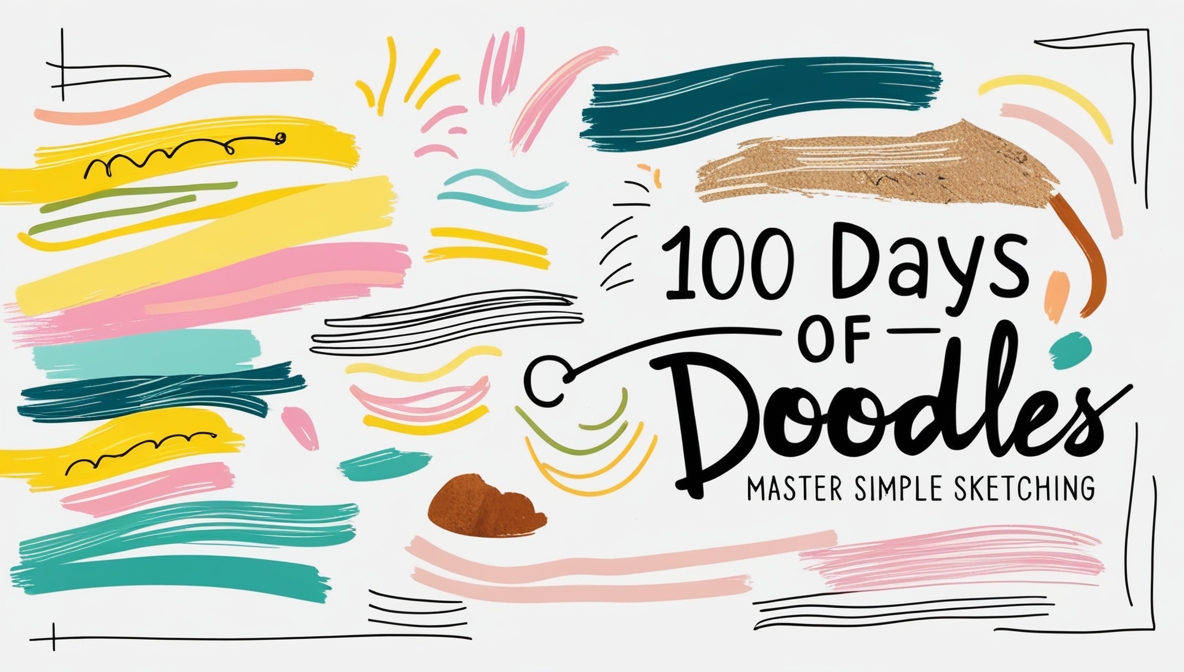Doodling isn’t just idle scribbling—it’s a fun and approachable way to unlock creativity, refine your drawing skills, and create cool symbols that express your style. Over 100 days, you can develop a habit that improves hand-eye coordination, enhances observation skills, and builds artistic confidence. Whether you’re a beginner or seasoned artist, committing to a daily doodle challenge is an engaging path to self-expression. Here’s how you can make the most of this journey, one sketch at a time.
What You’ll Need to Get Started
To succeed in your 100-day doodling challenge, prepare your tools:
- Sketchbook or Paper: Choose something portable for flexibility.
- Pencils or Pens: Start simple. Fine liners, gel pens, or mechanical pencils are ideal.
- Eraser: A good-quality eraser helps refine your work.
- Optional Tools: Colored pencils, markers, or watercolors can add flair.
Keep your materials accessible to make doodling a seamless part of your day.
Setting Goals for the Challenge
Establish clear, achievable goals to stay motivated:
- Time Commitment: Dedicate 10-20 minutes daily.
- Themes: Focus on specific topics like animals, objects, or abstract patterns.
- Skill Focus: Improve techniques such as shading, proportions, or line work.
Daily Prompts for 100 Days
Using prompts can provide inspiration and direction. Below is a categorized list of ideas to guide your journey:
Week 1: Lines and Patterns
- Day 1: Straight and curved lines
- Day 2: Spirals
- Day 3: Crosshatching
- Day 4: Zigzags
- Day 5: Waves
- Day 6: Abstract patterns
- Day 7: Mandalas
Week 2: Shapes and Forms
- Day 8: Circles and spheres
- Day 9: Squares and cubes
- Day 10: Triangles and pyramids
- Day 11: Hexagons
- Day 12: Stars
- Day 13: Geometric patterns
- Day 14: Overlapping shapes
Week 3: Nature
- Day 15: Leaves
- Day 16: Trees
- Day 17: Flowers
- Day 18: Grass and bushes
- Day 19: Mountains
- Day 20: Oceans
- Day 21: Clouds
Week 4: Everyday Objects
- Day 22: Coffee cups
- Day 23: Books
- Day 24: Keys
- Day 25: Shoes
- Day 26: Sunglasses
- Day 27: Bags
- Day 28: Lamps
Week 5: People and Faces
- Day 29: Eyes
- Day 30: Noses
- Day 31: Lips
- Day 32: Hands
- Day 33: Hair
- Day 34: Silhouettes
- Day 35: Expressions
Week 6: Animals
- Day 36: Cats
- Day 37: Dogs
- Day 38: Birds
- Day 39: Fish
- Day 40: Butterflies
- Day 41: Horses
- Day 42: Turtles
Week 7: Abstract and Surreal
- Day 43: Doodles from random scribbles
- Day 44: Dreamscapes
- Day 45: Optical illusions
- Day 46: Maze-like patterns
- Day 47: Abstract portraits
- Day 48: Fluid shapes
- Day 49: Fragmented objects
Week 8: In Motion
- Day 50: Vehicles
- Day 51: Dancing figures
- Day 52: Birds in flight
- Day 53: Flowing water
- Day 54: Falling leaves
- Day 55: Running animals
- Day 56: Moving clouds
Week 9: Seasonal Themes
- Day 57: Spring blossoms
- Day 58: Summer landscapes
- Day 59: Autumn leaves
- Day 60: Winter snowflakes
- Day 61: Rainy day doodles
- Day 62: Sunshine patterns
- Day 63: Holiday motifs
Week 10: Personal Favorites
- Day 64-70: Revisit and refine favorite subjects from previous weeks.
Weeks 11-14: Freestyle
- Day 71-100: Experiment with combining different techniques and styles. Allow creativity to flow naturally.
Techniques to Practice Along the Way
Focus on one or two techniques each week to improve consistency and detail:
- Hatching and Crosshatching: Use these for shading and depth.
- Stippling: Create texture with dots.
- Contour Lines: Define shapes with clean outlines.
- Perspective Drawing: Practice objects in 3D spaces.
- Gesture Sketching: Capture motion and emotion quickly.
Tips for Staying Motivated
- Set a Reminder: Choose a specific time daily to doodle.
- Track Progress: Keep a checklist or calendar to mark completed days.
- Share Your Work: Post online or with friends for encouragement.
- Reward Milestones: Celebrate after 10, 50, and 100 days with a small treat.
Participating in a 100 day challenge keeps you accountable and helps develop a consistent habit. Tracking your progress visually can make the process even more rewarding.
How to Overcome Creative Blocks
Even the most committed artists face moments of hesitation. Here’s how to keep going:
- Try Random Shapes: Scribble freely and turn it into something recognizable.
- Switch Mediums: Use colors or textured paper for variety.
- Use References: Look at photos or other artists’ work for inspiration.
- Take a Break: Rest briefly to refresh your mind.
Benefits of 100 Days of Doodling
Doodling daily offers more than artistic improvement. Key benefits include:
- Stress Relief: Focused drawing calms the mind.
- Increased Creativity: Regular practice sparks innovative ideas.
- Skill Development: Incremental progress refines techniques.
- Self-Expression: Explore emotions and thoughts visually.
Beyond the 100 Days
After completing the challenge, you’ll have a portfolio of unique sketches. Use this foundation to:
- Experiment Further: Tackle larger, more detailed drawings.
- Create Art Projects: Develop prints, cards, or other creative items.
- Teach Others: Share your experience with aspiring artists.
Doodling is a small yet impactful step toward mastering the art of sketching. Commit to this challenge, and let your pen or pencil bring ideas to life one day at a time. If you enjoyed this journey, consider exploring other creative endeavors like a 100 day drawing challenge, focusing on more detailed projects or specific artistic themes.






